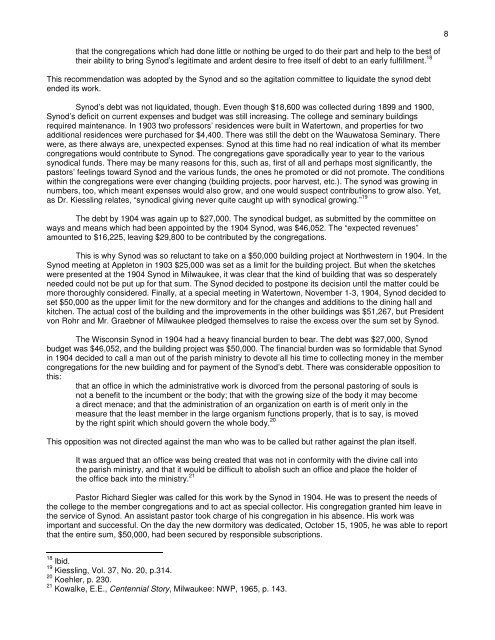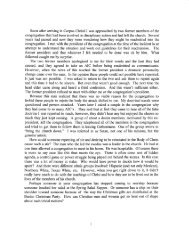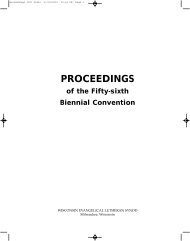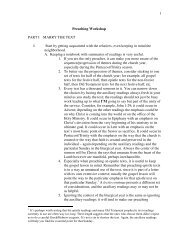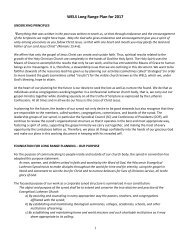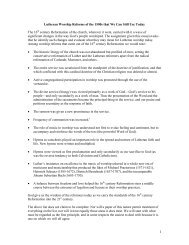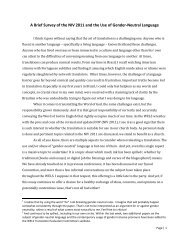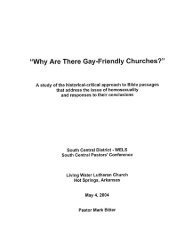A History of the WELS - The South Central District
A History of the WELS - The South Central District
A History of the WELS - The South Central District
Create successful ePaper yourself
Turn your PDF publications into a flip-book with our unique Google optimized e-Paper software.
8<br />
that <strong>the</strong> congregations which had done little or nothing be urged to do <strong>the</strong>ir part and help to <strong>the</strong> best <strong>of</strong><br />
<strong>the</strong>ir ability to bring Synod’s legitimate and ardent desire to free itself <strong>of</strong> debt to an early fulfillment. 18<br />
This recommendation was adopted by <strong>the</strong> Synod and so <strong>the</strong> agitation committee to liquidate <strong>the</strong> synod debt<br />
ended its work.<br />
Synod’s debt was not liquidated, though. Even though $18,600 was collected during 1899 and 1900,<br />
Synod’s deficit on current expenses and budget was still increasing. <strong>The</strong> college and seminary buildings<br />
required maintenance. In 1903 two pr<strong>of</strong>essors’ residences were built in Watertown, and properties for two<br />
additional residences were purchased for $4,400. <strong>The</strong>re was still <strong>the</strong> debt on <strong>the</strong> Wauwatosa Seminary. <strong>The</strong>re<br />
were, as <strong>the</strong>re always are, unexpected expenses. Synod at this time had no real indication <strong>of</strong> what its member<br />
congregations would contribute to Synod. <strong>The</strong> congregations gave sporadically year to year to <strong>the</strong> various<br />
synodical funds. <strong>The</strong>re may be many reasons for this, such as, first <strong>of</strong> all and perhaps most significantly, <strong>the</strong><br />
pastors’ feelings toward Synod and <strong>the</strong> various funds, <strong>the</strong> ones he promoted or did not promote. <strong>The</strong> conditions<br />
within <strong>the</strong> congregations were ever changing (building projects, poor harvest, etc.). <strong>The</strong> synod was growing in<br />
numbers, too, which meant expenses would also grow, and one would suspect contributions to grow also. Yet,<br />
as Dr. Kiessling relates, “synodical giving never quite caught up with synodical growing.” 19<br />
<strong>The</strong> debt by 1904 was again up to $27,000. <strong>The</strong> synodical budget, as submitted by <strong>the</strong> committee on<br />
ways and means which had been appointed by <strong>the</strong> 1904 Synod, was $46,052. <strong>The</strong> “expected revenues”<br />
amounted to $16,225, leaving $29,800 to be contributed by <strong>the</strong> congregations.<br />
This is why Synod was so reluctant to take on a $50,000 building project at Northwestern in 1904. In <strong>the</strong><br />
Synod meeting at Appleton in 1903 $25,000 was set as a limit for <strong>the</strong> building project. But when <strong>the</strong> sketches<br />
were presented at <strong>the</strong> 1904 Synod in Milwaukee, it was clear that <strong>the</strong> kind <strong>of</strong> building that was so desperately<br />
needed could not be put up for that sum. <strong>The</strong> Synod decided to postpone its decision until <strong>the</strong> matter could be<br />
more thoroughly considered. Finally, at a special meeting in Watertown, November 1-3, 1904, Synod decided to<br />
set $50,000 as <strong>the</strong> upper limit for <strong>the</strong> new dormitory and for <strong>the</strong> changes and additions to <strong>the</strong> dining hall and<br />
kitchen. <strong>The</strong> actual cost <strong>of</strong> <strong>the</strong> building and <strong>the</strong> improvements in <strong>the</strong> o<strong>the</strong>r buildings was $51,267, but President<br />
von Rohr and Mr. Graebner <strong>of</strong> Milwaukee pledged <strong>the</strong>mselves to raise <strong>the</strong> excess over <strong>the</strong> sum set by Synod.<br />
<strong>The</strong> Wisconsin Synod in 1904 had a heavy financial burden to bear. <strong>The</strong> debt was $27,000, Synod<br />
budget was $46,052, and <strong>the</strong> building project was $50,000. <strong>The</strong> financial burden was so formidable that Synod<br />
in 1904 decided to call a man out <strong>of</strong> <strong>the</strong> parish ministry to devote all his time to collecting money in <strong>the</strong> member<br />
congregations for <strong>the</strong> new building and for payment <strong>of</strong> <strong>the</strong> Synod’s debt. <strong>The</strong>re was considerable opposition to<br />
this:<br />
that an <strong>of</strong>fice in which <strong>the</strong> administrative work is divorced from <strong>the</strong> personal pastoring <strong>of</strong> souls is<br />
not a benefit to <strong>the</strong> incumbent or <strong>the</strong> body; that with <strong>the</strong> growing size <strong>of</strong> <strong>the</strong> body it may become<br />
a direct menace; and that <strong>the</strong> administration <strong>of</strong> an organization on earth is <strong>of</strong> merit only in <strong>the</strong><br />
measure that <strong>the</strong> least member in <strong>the</strong> large organism functions properly, that is to say, is moved<br />
by <strong>the</strong> right spirit which should govern <strong>the</strong> whole body. 20<br />
This opposition was not directed against <strong>the</strong> man who was to be called but ra<strong>the</strong>r against <strong>the</strong> plan itself.<br />
It was argued that an <strong>of</strong>fice was being created that was not in conformity with <strong>the</strong> divine call into<br />
<strong>the</strong> parish ministry, and that it would be difficult to abolish such an <strong>of</strong>fice and place <strong>the</strong> holder <strong>of</strong><br />
<strong>the</strong> <strong>of</strong>fice back into <strong>the</strong> ministry. 21<br />
Pastor Richard Siegler was called for this work by <strong>the</strong> Synod in 1904. He was to present <strong>the</strong> needs <strong>of</strong><br />
<strong>the</strong> college to <strong>the</strong> member congregations and to act as special collector. His congregation granted him leave in<br />
<strong>the</strong> service <strong>of</strong> Synod. An assistant pastor took charge <strong>of</strong> his congregation in his absence. His work was<br />
important and successful. On <strong>the</strong> day <strong>the</strong> new dormitory was dedicated, October 15, 1905, he was able to report<br />
that <strong>the</strong> entire sum, $50,000, had been secured by responsible subscriptions.<br />
18 Ibid.<br />
19 Kiessling, Vol. 37, No. 20, p.314.<br />
20 Koehler, p. 230.<br />
21 Kowalke, E.E., Centennial Story, Milwaukee: NWP, 1965, p. 143.


